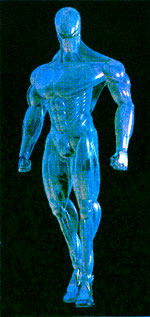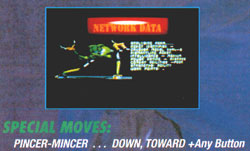
I wonder sometimes, if the pages of gaming magazines aren't laced with powerful suggestive drugs. Case in point: several years ago, I was flipping through a back issue of Nintendo Power and found a preview for Rise of the Robots, a game which shall live in infamy. Deep down, I knew from the screenshots of the awkwardly-postured blue guy fighting a terminally squatting red guy that the game would be as bad as their stances, probably worse. The fact that they once printed a six-page article on Weapon Lord, Namco's crappy conceptual 2-D version of Soul Edge (thank God they managed to get the weapon-fighting formula down better in the Soul fighters) and neglected Rise should have set off warning lights and sirens. Hell-kite, it was released by ACCLAIM. But no, something inside my naive teenage head told me that the game must surely have something going for it. Why, it has ray-traced graphics and full 3-D FMV sequences! The game's major claim, the aforementioned 'ray-traced graphics' basically meant that they constructed 3-D models of every robot then exported them for use as regular sprites. That's kind of like spending years on an exquisite oil painting, having it hung up in a museum, then sealed behind a brick wall and painted over so they can display one of those post-modern paintings of a blue dot on a white canvas. Oh wait, the soundtrack features a number by Brian May, former Queen guitarist. Unfortunately, Mirage Studios decided on a peculiar tactic that involved having a psuedo big-name musician create the worst theme in the entire game. His original piece for Rise, "The Dark," consists of a long guitar chord going down, then one going back up, then the same two played a little shorter. If I could convert the sound to text, it'd probably best fit as *BOM... nyeeeeeeeeeeeeeeer.... *BOM... NYYYAAAeeeer.... *BOM.... nyeeeer-nyaaaaarrrr...
Gimmicks and graphics aside, Rise of the Robots is a thoroughly depressing muck through a game that has less gameplay value than Urban Champions, the classic NES title from which all street fighters are ultimately derived. Urban Champions had a pair of nearly identical guys who would fight in front of one building until one of them falls offscreen or down a manhole. Then the winner would walk down the street a little and fight the same guy in front of the next store. There were only two moves, a high and low punch. And yet UC manages to be more fun overall than Rise. Horrible, unresponsive controls. Useless special moves. You can't even use special moves without going out of your way to the options menu and turning them on. The two-player mode seems more like a bug-testing feature the programmers forgot to remove, since Player 1 is forced to play as the same guy, and player two gets to choose from all of the other robots. Yes, that's right, this game has a vs. mode that only allows player two to select a character. Most of the enemy robots aren't that special, though. The first couple are depressingly slow, weak cannon fodder, and the next three and boss (who is hidden and therefore automatically good) are the only robots who pose any sort of challenge to The Cyborg, or for that matter, small mammals and the infirm elderly.
The plot is fairly straightforward: It's boring and you don't care. But regardless, a robot factory/city gets infected with a virus, causing them to (duh) go insane and threaten the safety of the tiny fraction of the population that is comprised of real, be-fleshed human beings. The last hope for survival for these future people who obviously haven't seen a sci-fi movie about insane computers?
Magnus, Robot HunterM.D GeistMegamanXZeroThe Cyborg! Within his blue frame is a human brain, which means he can enter the city without getting infected. In spite of the fact the Cyborg getting infected with the virus is apparently the entire premise behind the game's ill-gotten sequel. Then, he must purge the virus from all the infected robots and their Supervisor by engaging them in hand-to-hand combat. ("In order minimize damage to the plant, the cyborg was to be unarmed," the instruction book rationalizes.) Of course, there are only six opponents in the game, and the opening sequence claims there are upwards of 30,000 in the city, but maybe we can take this as a small hint of mercy on Acclaim's part. At his disposal are not one, but two special moves. One is a sluggish shoulder ram that puts you in the enemy's waiting pincers, and the other is a complex maneuver where he leaps into the air and slams his head into the enemy. Which might be a good move if not for the fact that his distinguishing characteristic is, again, a very squishy human brain jostling around inside his head.Even though at the time of its release there were already about four Street Fighter II titles out on the Super NES alone, and Mortal Kombat had already been fairly well-established, don't cry for Rise of the Robots. And don't waste your tears on the people who have already given up tiny portions of their lives to the game; we're already dead, at least on the inside. Learn well from our mistakes, young one. And for god's sake, listen to all those stupid 'insane computer scenario' sci-fi movies. Or at least keep them in mind when you design a mainframe that has the ability to control eveything in your house right down to opening and closing doors.

For those of you who want to play a game with less than 1/3rd of the playyability of the original Fatal Fury...
...and are okay with having the Cyborg and his featureless blue nudity onscreen at all times...
...and think 'pincer-mincer' is a really cool name for a special move...
Die.


